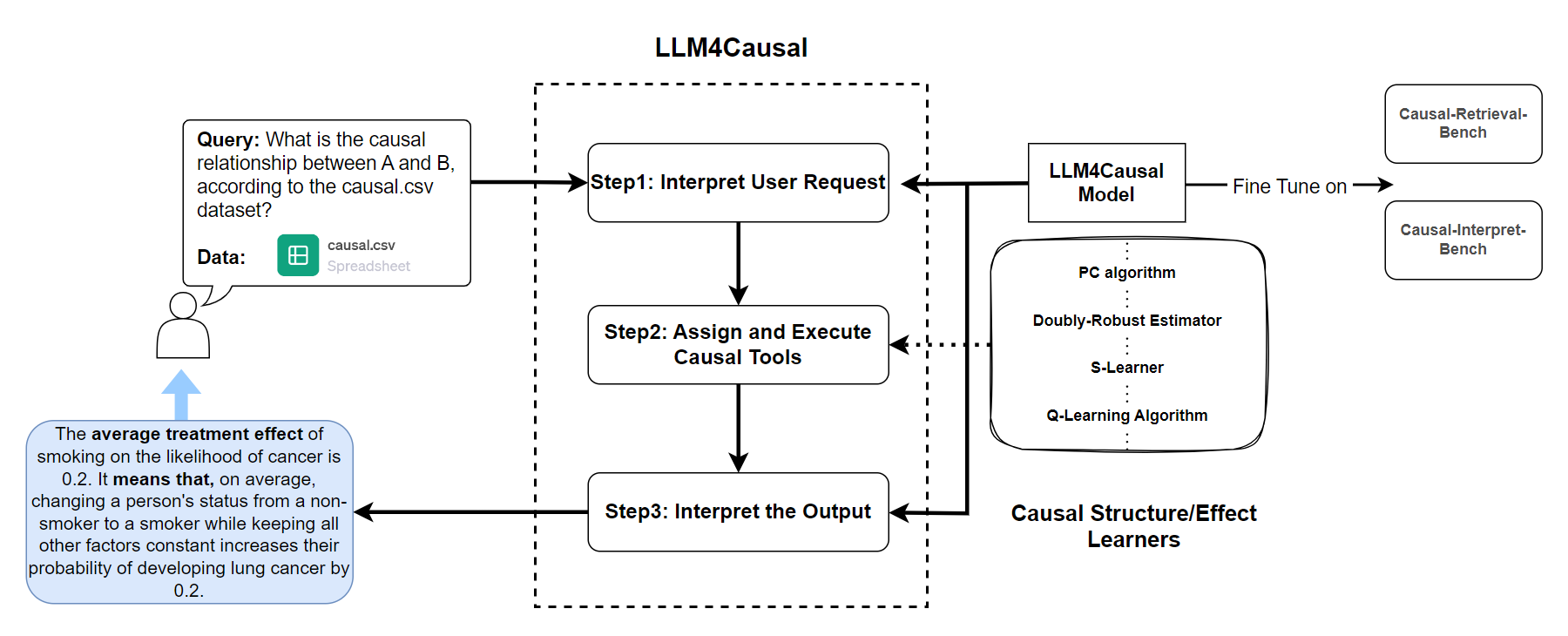Causal Graph Discovery with Retrieval-Augmented Generation based Large Language Models
2402.15301

0
0

Abstract
Causal graph recovery is traditionally done using statistical estimation-based methods or based on individual's knowledge about variables of interests. They often suffer from data collection biases and limitations of individuals' knowledge. The advance of large language models (LLMs) provides opportunities to address these problems. We propose a novel method that leverages LLMs to deduce causal relationships in general causal graph recovery tasks. This method leverages knowledge compressed in LLMs and knowledge LLMs extracted from scientific publication database as well as experiment data about factors of interest to achieve this goal. Our method gives a prompting strategy to extract associational relationships among those factors and a mechanism to perform causality verification for these associations. Comparing to other LLM-based methods that directly instruct LLMs to do the highly complex causal reasoning, our method shows clear advantage on causal graph quality on benchmark datasets. More importantly, as causality among some factors may change as new research results emerge, our method show sensitivity to new evidence in the literature and can provide useful information for updating causal graphs accordingly.
Create account to get full access
Overview
- This research paper explores the use of large language models (LLMs) for causal graph discovery, which involves identifying the causal relationships between variables in a system.
- The authors propose a retrieval-augmented generation approach that combines the strength of LLMs with the ability to retrieve relevant factual knowledge from a database.
- The goal is to enable LLMs to not only generate plausible causal explanations but also ground them in empirical evidence, leading to more robust and trustworthy causal discoveries.
Plain English Explanation
The paper is about using large language models to figure out the causal connections between different things. Causal connections are the relationships where one thing directly causes another, like how smoke causes fire.
The researchers developed a new approach that combines the impressive language abilities of large language models with the ability to quickly find and use relevant facts from a database. This allows the language models to not only come up with plausible causal explanations, but also back them up with evidence, making the results more trustworthy.
The key idea is to have the language model generate possible causal relationships, and then check those against a database of information to see if the connections make sense based on real-world facts. This way, the model doesn't just make up stories, but grounds its causal discoveries in actual evidence.
Technical Explanation
The paper proposes a retrieval-augmented generation approach to causal graph discovery using large language models. The authors start by framing causal graph discovery as a structured prediction task, where the goal is to infer the directed acyclic graph (DAG) that best represents the causal relationships between a set of variables.
To tackle this challenge, the authors leverage the strengths of large language models, which have shown impressive capabilities in generating plausible causal explanations. However, they also recognize the limitations of language models in grounding their generated outputs in empirical evidence.
The proposed retrieval-augmented generation approach addresses this by integrating the language model with a retrieval module that can quickly find relevant factual information from a database. This allows the language model to not only generate candidate causal relationships, but also assess their plausibility and coherence with respect to the retrieved evidence.
The authors evaluate their approach on several benchmark causal discovery datasets and demonstrate its effectiveness in inferring causal graphs compared to both traditional causal discovery methods and language model-only baselines.
Critical Analysis
The paper presents a promising approach for leveraging the strengths of large language models in causal graph discovery. By integrating retrieval capabilities, the authors address an important limitation of language models, which is their tendency to generate plausible-sounding but factually unsupported outputs.
However, the authors acknowledge that their approach is still limited by the quality and coverage of the underlying database. If the database does not contain the relevant factual information needed to validate the generated causal hypotheses, the approach may still struggle to produce accurate causal graphs.
Additionally, the paper does not explore the interpretability and transparency of the causal explanations generated by the model. It would be valuable to understand how the model arrives at its causal conclusions and how the retrieved evidence is used to support them.
Further research could also investigate the ability of this approach to handle more complex causal scenarios, such as those involving hidden confounders or feedback loops, which are common in real-world systems.
Conclusion
This research paper presents a novel approach to causal graph discovery that leverages the strengths of large language models while addressing their limitations through the integration of a retrieval module. By grounding the generated causal explanations in empirical evidence, the proposed method shows promise in producing more robust and trustworthy causal discoveries.
The findings of this work contribute to the growing body of research on the capabilities and limitations of large language models in reasoning about causal relationships, with potential applications in scientific discovery, decision-making, and other domains where understanding causal structures is crucial.
This summary was produced with help from an AI and may contain inaccuracies - check out the links to read the original source documents!
Related Papers

Large Language Models for Constrained-Based Causal Discovery
Kai-Hendrik Cohrs, Gherardo Varando, Emiliano Diaz, Vasileios Sitokonstantinou, Gustau Camps-Valls

0
0
Causality is essential for understanding complex systems, such as the economy, the brain, and the climate. Constructing causal graphs often relies on either data-driven or expert-driven approaches, both fraught with challenges. The former methods, like the celebrated PC algorithm, face issues with data requirements and assumptions of causal sufficiency, while the latter demand substantial time and domain knowledge. This work explores the capabilities of Large Language Models (LLMs) as an alternative to domain experts for causal graph generation. We frame conditional independence queries as prompts to LLMs and employ the PC algorithm with the answers. The performance of the LLM-based conditional independence oracle on systems with known causal graphs shows a high degree of variability. We improve the performance through a proposed statistical-inspired voting schema that allows some control over false-positive and false-negative rates. Inspecting the chain-of-thought argumentation, we find causal reasoning to justify its answer to a probabilistic query. We show evidence that knowledge-based CIT could eventually become a complementary tool for data-driven causal discovery.
6/12/2024

Large Language Model for Causal Decision Making
Haitao Jiang, Lin Ge, Yuhe Gao, Jianian Wang, Rui Song

0
0
Large Language Models (LLMs) have shown their success in language understanding and reasoning on general topics. However, their capability to perform inference based on user-specified structured data and knowledge in corpus-rare concepts, such as causal decision-making is still limited. In this work, we explore the possibility of fine-tuning an open-sourced LLM into LLM4Causal, which can identify the causal task, execute a corresponding function, and interpret its numerical results based on users' queries and the provided dataset. Meanwhile, we propose a data generation process for more controllable GPT prompting and present two instruction-tuning datasets: (1) Causal-Retrieval-Bench for causal problem identification and input parameter extraction for causal function calling and (2) Causal-Interpret-Bench for in-context causal interpretation. By conducting end-to-end evaluations and two ablation studies, we showed that LLM4Causal can deliver end-to-end solutions for causal problems and provide easy-to-understand answers, which significantly outperforms the baselines.
4/15/2024
💬
Large Language Models are Effective Priors for Causal Graph Discovery
Victor-Alexandru Darvariu, Stephen Hailes, Mirco Musolesi

0
0
Causal structure discovery from observations can be improved by integrating background knowledge provided by an expert to reduce the hypothesis space. Recently, Large Language Models (LLMs) have begun to be considered as sources of prior information given the low cost of querying them relative to a human expert. In this work, firstly, we propose a set of metrics for assessing LLM judgments for causal graph discovery independently of the downstream algorithm. Secondly, we systematically study a set of prompting designs that allows the model to specify priors about the structure of the causal graph. Finally, we present a general methodology for the integration of LLM priors in graph discovery algorithms, finding that they help improve performance on common-sense benchmarks and especially when used for assessing edge directionality. Our work highlights the potential as well as the shortcomings of the use of LLMs in this problem space.
5/24/2024

Evaluating Interventional Reasoning Capabilities of Large Language Models
Tejas Kasetty, Divyat Mahajan, Gintare Karolina Dziugaite, Alexandre Drouin, Dhanya Sridhar

0
0
Numerous decision-making tasks require estimating causal effects under interventions on different parts of a system. As practitioners consider using large language models (LLMs) to automate decisions, studying their causal reasoning capabilities becomes crucial. A recent line of work evaluates LLMs ability to retrieve commonsense causal facts, but these evaluations do not sufficiently assess how LLMs reason about interventions. Motivated by the role that interventions play in causal inference, in this paper, we conduct empirical analyses to evaluate whether LLMs can accurately update their knowledge of a data-generating process in response to an intervention. We create benchmarks that span diverse causal graphs (e.g., confounding, mediation) and variable types, and enable a study of intervention-based reasoning. These benchmarks allow us to isolate the ability of LLMs to accurately predict changes resulting from their ability to memorize facts or find other shortcuts. Our analysis on four LLMs highlights that while GPT- 4 models show promising accuracy at predicting the intervention effects, they remain sensitive to distracting factors in the prompts.
4/9/2024